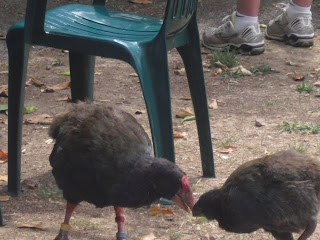The Auckland Zoo is much more relaxed about human/animal encounters than zoos in America. Here's Rachel feeding a giraffe.

The Emu, native to Australia, are basically free to roam around and mingle with visitors. Rachel looks nervous, like the emu might attack her.

Tiritiri Matangi is a wildlife sanctuary and scientific resource center that has been reforested with native plants, scrubbed of all invasive mammals (except humans of course), and repopulated with many species of New Zealand native birds that are on the verge of extinction.
With the exception of a few small bats, New Zealand had no mammals until the arrival of the Maori. Birds, with no predators to eat them or their eggs, ruled the roost; they were at the top of the food chain.
When the Maori arrived they were not alone. They brought with them the Polynesian Rat, which was a Maori dietary staple. The Maori feasted on the larger birds too, particularly the Moa, which they hunted to extinction. The Moa, having never encountered a predator, made for easy prey. Meanwhile the rats ate the easily accessible bird eggs (many species of birds nested on the ground since there were no threats such as rats or snakes) and competed with the birds for food. Although this was bad news for the birds of New Zealand things would get worse. Much worse. Soon (in evolutionary time) Europeans would arrive and bring cats, Norwegian rats, possums, pigs, and their own song birds. This spelled doom for many native species, and pushed many more to the edge.
Luckily places like Tiritiri Matangi have been set aside to help the birds that survived. Many of these species unfortunately, are still close to extinction.
One of the worlds greatest song birds is the Tui. Its range of notes and ability to communicate is simply amazing. Ornithologists have speculated that because New Zealand bush cover was so dense, bright plumage did not enhance a bird's ability to communicate or to be amorous. Birds made up for this with their song. No bird better exemplifies this than the Tui.

Here is a short sample of the Tui song.
The Kereru is New Zealand's only native pigeon. Although they can fly, they prefer to hop from branch to branch. The density of the native New Zealand bush made hopping much easier than flying.

The Takahe was once thought to be extinct, but in 1948 a small number were found in the Murchison Mountains. Through breeding programs, there are about 300 Takahe today.

This Takahe's name is Greg, pictured below with his baby. The Takahe have low reproduction rates, on average one clutch a year with two eggs. The male and female split parenting duties, and juveniles will stay with parents for up to two years

Like the Moa, the Takahe is a fearless and curious bird and easy to hunt. Its inquisitiveness was too much for Rachel. And no, Rachel did not feed the bird potato chips.

A bird similar to the Takahe in stature and build is the Pukeko. Both the Takahe and Pukeko are members of the Rail family. Unlike other native species though the Pukeko had done well since mammals have come to the island. Unlike the Takahe the Pukeko can fly.

Tiritiri Matangi also has Blue Penguins. Blue Penguins are the smallest members of the penguin family.
_-group_at_Adelaide_Zoo.jpg)
They also come ashore and leave under the cover of night. This makes them hard to see. Stone nesting structures have been built on Tritiri Matangi for the penguins to nest. There are lids on top of the nest and open them and look down on the birds nesting.

How could there be a blog about New zealand birds without mentioning the national symbol, the Kiwi. Kiwis are incredibly hard to spot in the wild; they are shy animals that only come out under the cover of darkness. This elusiveness may be one of the reasons they were not wiped out. Rachel and I saw kiwis on display at the zoo, but did not see any on Tiritiri Matangi since we didn't stay over night.


AHHHH the picture with Rachel huddled up in the chair while the Moa feasts below is the greatest picture ever!! It reminds me of just how awesome that must be for her -- she's at that age where she is smart enough to have a grounded world view, but then how cool to be taken to a new place like New Zealand where the rules of life are completely changed up! Haha, it just makes me feel this completely sense of childish glee! I wish that I was still, in the back of my mind, a little bit worried about the prospect of an Emu surprise-attack during the course of my daily routine.
ReplyDeleteGreat post! Photos of the blog are very nice, Tiritiri Matangi is a place where one can enjoy the beauty of native bird song amidst bushland. The island is home to about 78 different species of birds, including some of the most endangered ones like Kokako, Stitchbird and Takahe. Besides, little spotted kiwi, Brown teal pateke, Takahe, Red-crowned parakeet, Whitehead, North Island robin, North Island saddleback, Fernbird matata and North Island Tomtit are also spotted in this island.
ReplyDelete